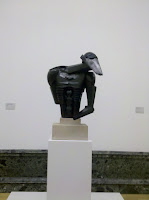these are the photos I took when i went to TATE Britain and looked at the famous painter Turner and other artists from the 19-20 century
JMW Turner 1775-1851
The Garreteer's Petition
exhibited 1809
oil on wood
the poet in this genre subjected is illuminated in a pool of light, his pen poised awating inspiration, the theme was expressed in verse Turner wrote to accompany the painting
Inspiration, however has not been forthcoming. the squalid attic room attests to the poet's porverty, and his next line, according to Turner's verse, is'long-sought'
while Turner sympathised with the Romantic suffering of the poet, he has also introudced an element of satire. The paintingemulates the stel of Turner's contemporary and rival, David Wilkie
JMW Turner 1775 - 1851
Self Portrait about 1799
Thought to have been painted on the occasion of his election as an associate of the royal academy, this self protrait presents the twenty-four-old Joseph Mallord William Turner as a rather dapper and self-condifent young man a strong and direct light, perhaps a metaphor for the light of intellect and inspiration, isolates him against a dark background, withnone of the attributes of an artist- brushes, palette, easel or canvas - we are left to consider him as an individual.
very few likenesses of turner were made from life. this is his only certain self-portrait in oil
Henry Monro 1791 - 1814
Henry Monro was the son of Dr Thomas Monro, a collector and host of the famous London ‘Academy’ where the young Turner copied and studied drawing. This picture won a premium of one hundred guineas at the British Institution in 1813, the year before his untimely death. The Institution was keen to promote historical painting by British artists.Henry VIII humbles his over-mighty subject, Cardinal Wolsey. British painters had led the Romantic fashion for historicism and painting subjects from the national past. Their pictures were to influence French painters like Paul Delaroche, who were interested in the evolution of constitutional monarchy.
James Barry 1741- 1806
King Lear Weeping over the Dead Body
of Cordelia 1786 - 8
This large paingint demonstarates the new imaginative engagement with Shakespeare as literature among ambitious artists of the 1780s, Barry shows the savage tragedy that concludes kine lear, with the made monarch despairing over the limp body of this daughter Cordelia, and carnage all around. this brudtal scene was censored in stage versions of the play at the time Barry has returned to Shakesspeare;s poetic originaltext, and has painted in an epic high-minded style to match
John Opie 1761 - 1807
Portrait of a Lady in the Character of Cressida exhibited 1800
After his death in 1807, Opie became removed as a quintessential Romantic artist, A self - taught painter from the west country, he became known as the 'Cornish wonder', this painting is an example of his practice of using portraiture to explore emotion, character and performance. the subject is the heroine of Shakespeare's Troilus and Cressida 1602, a play of love and betrayal during the siege of Troy by the Greeks
John Craxton 1922 - 2009
still life with Cat and Child 1959 tempera paint on board
still life wit Cat and Child was probably painted in the latter half of 1959 on the Greek island of Hydra, where Craxton was staying with his friend, the artist Nicolas Ghika (1906 - 1994)
John Craxton
1992 - 2009
hotel by the sea 1946
hotel by the sea 1946
oil paint on canvas
Hotel by the sea was painted in the summer of 1946 on the island of Poros. this was the artist's first Greek landscape and was completed in the studio from drawings made on the site. it was included in his solo exhibition in December 1946 at the British Institute in Athens.
John Craxton 1922 -2009
Alderholt Mill 1943-4
oil paint on board
Alderholt Mill in Dorset was the home of the designer E.Q. Nicholson who was, with Peter Watson and Lady Norton, one of the main supporters of Craxton in his early years. Craxton wrote to Nicholoson in 1942 'that all the best pictures that I have done have been done with you, down at Alderholt
Frank Dobson 1888 - 1963
Sir Osbert Sitwell, Bt 1923
Bronze
Jacob Epstein 1880 - 1959
Portrait of Iris Beerbohm Tree 1915 Bronze













































1 comments:
Hi,
Wow, you have chosen a wonderfull selection of art to get inspiration from. I want you to choose three or more of your favourite artists and make strong links to your work. For example you could compare and use some of the techniques used by the masters to your own depiction of your summer with your family. Many of the works chosen are family portraits or paintings of where the artists have stayed.You could link some of the techniques used to the way you depict your own family in italy. This is why you need to complete a detailed written record of your summer with family and friends.
Post a Comment